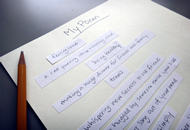Lesson Plan: Hurrah for Poetry!
by Sarah Sahr
 For years, I have enjoyed helping English language learners explore the joys of poetry. And because April is National Poetry Month in the USA, what better time to share the crazy fun students can have with creating poems of their own? Now, I’m not talking about the kind of poems that rhyme, I’m talking about the poems that our students might not recognize right away as poems. For example, have you ever heard of Cinquain Poems? These simple 5-line poems help students to touch base with parts of speech and description (more information can be found on PIZZAZ). However, we’re going to go a bit further… I like to have students create poems about what they love the most.
For years, I have enjoyed helping English language learners explore the joys of poetry. And because April is National Poetry Month in the USA, what better time to share the crazy fun students can have with creating poems of their own? Now, I’m not talking about the kind of poems that rhyme, I’m talking about the poems that our students might not recognize right away as poems. For example, have you ever heard of Cinquain Poems? These simple 5-line poems help students to touch base with parts of speech and description (more information can be found on PIZZAZ). However, we’re going to go a bit further… I like to have students create poems about what they love the most.
| Materials: Poem print-outs, brown lunch bags, several slips of paper or 3” x 5” cards cut in half (at least 10 per student), glue, and construction paper |
| Audience: Middle school students, ages 11–13; upper intermediate |
Objective: Students will be able to analyze two distinct forms of poetry.
Students will be able to differentiate between poetry styles. |
| Outcome: Students will write a poem of their favorite things. |
| Duration: 50–65 minutes (times are approximate) |
Introduction (15 minutes)
It is important that you start class without students knowing what they are about to do.
Have students line up in alphabetical order by their first names. From there, form groups of four to five students. This can be by counting off (all “1s” are a group, all “2s” are a group, etc.), or you can just take the first four to five student and make a group, the next four to five students and make a group, etc. Hand out the following poems, one to each group:
- The Game of Fives
- A Boat Beneath the Sunny Sky
- Echoes
- The Crocodile
- You are old Father William
(These are all Lewis Carroll poems; more Lewis Carroll poems can be found here. Also check out PoemHunter’s Top 500 Poets list to access thousands of other poems.)
After about 5 minutes, ask students, what are these?
Next, hand out the following poems to the groups (do not change the print formatting). Ask students to try and make sense of them. What are they?
- because it’s
- r-p-o-p-h-e-s-s-a-g-r
- l(a
- silence
- !blac…
(These are all e.e. cummings poems; more e.e. cummings poems can be found here.)
After about 5 minutes, ask students, what are these?
Hopefully, by now, you have reached a point in class where students are inferring that poetry can take on many different forms. Ask students, “Which type of poem do you prefer? Why?”
Preparing (15–20 minutes)
For the actual construction of a poem, students will leave their groups and find a place where they can focus on their work. Give each student a brown paper page and several slips of paper. On each slip of paper, students will write down a thing they enjoy; we’ll refer to these as poem starters. It can be something they enjoy doing, being, having, hearing, feeling, and so on. Remind them to write only one poem starter per piece of paper. As they finish writing their starters on the slips of paper, the papers go into the brown paper bag. It would be great if each student came up with at least 10 starters.
Organizing (10 minutes)
Once students have all their slips of paper in their bags, have them shake the bags up! (There needs to be randomness to the next part of the activity.) Each student will pull a single slip of paper out of his or her bag, one at a time. The first slip of paper goes in the middle of the desk. Students pull a second slip and decide if it goes before or after the first. Students pull a third… where does it go? It is important to note to students that their starters do not have to be in any particular order. It can be completely random, they can arrange them in order of most to least favorite, or they can arrange them any other way they’d like; there is no set pattern in this type of poetry.
Closing (10 minutes)
Once students have pulled all their starters and arranged them on their desks, allow students to pick a colorful piece of construction paper. Students should glue their slips of paper to the construction paper in the order they appear on their desk. The arrangement on the paper does not have to be linear; some lines can be crooked (if space permits). It’s poetry… anything goes.
If needed, here is an example of what a student might come up with:
feeling loved
a cat purring while nestling close
being healthy
making a huge dinner for friends and family
tennis
whispering new secrets to old friends
being hugged by someone twice your size
getting that song out of your head
living simply
receiving another stamp in your passport
sitting by a campfire
knowing you have another 45 minutes of sleep
feeling safe
learning new things
having someone read to you
singing along with that song on the radio
haggling for a good deal
cookouts & croquet
72 and breezy
being at peace with all things
There is no need to collect these poems.* However, you are the teacher. It is your classroom. It might be nice to see what your students came up with.
Let me know how it goes…
Leave a comment below!
*Writing poetry can be very a very private event, especially for middle schoolers. It is important for students to know that their poems will be kept safe. As a teacher, I would use a lesson like this as an introduction to poetry; nothing more. I wouldn’t necessarily collect my students’ poems for grading. I might suggest that students can put them in their weekly journal entry or turn them in for a writer’s workshop piece.
____________________
Sarah Sahr works at TESOL and is currently pursuing her doctorate in education administration and policy at the George Washington University. Her professional career has taken her all over the world, most notably as a Peace Corps Volunteer in Ethiopia and as a traveling school teacher/administrator with Ringling Bros. and Barnum & Bailey circus. Sarah is also a certified ashtanga yoga instructor and has managed an eco-lodge in Chugchilan, Ecuador.
TESOL Blogs
Interested in writing a blog for TESOL?
Contact
Tomiko Breland with your idea or for details.
Check out the latest TESOL Blogs:
|
The Language Pill, Perpetual Toothbrushes, and Other Whimsical Inventions, by Alexandra Lowe
 Do you have certain communicative activities that you find work no matter what level you are teaching? Are there activities that you can always turn to when the energy in the classroom starts to flag? Do you have certain communicative activities that you find work no matter what level you are teaching? Are there activities that you can always turn to when the energy in the classroom starts to flag?
In this regard, I wanted to share with you an activity that Irina Climovici, a colleague from SUNY Westchester Community College, taught me last year and that has stood me in good stead ever since. I used it last week when it became apparent that my Level 5 evening students, who had enthusiastically debated the merits of investing in derelict buildings in Detroit and had written at length about the impact of the Great Recession on their own lives, were running out of steam as the clock ticked toward 9 p.m. Read More. |
|
From the Perspective of a Student, by Tara Arntsen
 Since I am advocating for teaching using technology, I would like to note that I have also studied extensively online using all sorts of technology. While it is not the same as integrating technology into traditional classroom-based lessons, I wanted to share these experiences with you anyway, mostly as proof that online learning is still real learning. My best experiences studying online have been with the University of Southern California and Udacity. Read More. Since I am advocating for teaching using technology, I would like to note that I have also studied extensively online using all sorts of technology. While it is not the same as integrating technology into traditional classroom-based lessons, I wanted to share these experiences with you anyway, mostly as proof that online learning is still real learning. My best experiences studying online have been with the University of Southern California and Udacity. Read More.
|
|
TESOL 2013 Graduate and Doctoral Student Forums Combine for Memorable Day, by Elena Andrei
 The TESOL Graduate Forum and the TESOL Doctoral Forum are wonderful one-day events usually held the Wednesday before the TESOL Annual Convention & English Language Expo. If you are a graduate student in TESOL, ESL/EFL, or applied linguistics, I would encourage you to attend. The TESOL Graduate Forum and the TESOL Doctoral Forum are wonderful one-day events usually held the Wednesday before the TESOL Annual Convention & English Language Expo. If you are a graduate student in TESOL, ESL/EFL, or applied linguistics, I would encourage you to attend.
At TESOL 2013, the Doctoral and Graduate Forums joined talents and forces. We had a great event in which students were involved in vibrant discussions about teaching, researching, and learning in the TESOL field.
One highlight of the day.... Read More. |